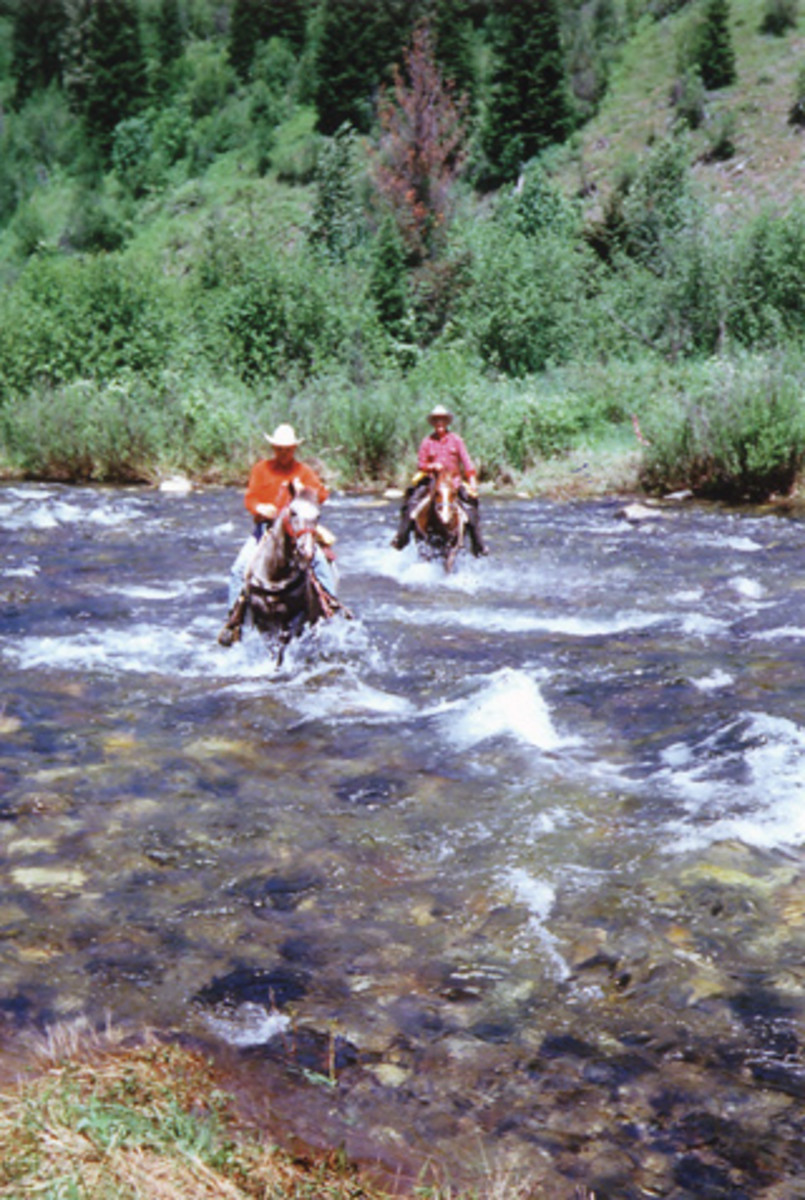
Imagine driving along a beautiful river for 60 miles with trailhead after trailhead of high mountain scenery awaiting you and your horse. As many riders are discovering, North Idaho has a lot to offer today’s horseman. With premier trails, great camp facilities, and awesome scenery, Idaho is inviting the equestrian world to paradise.
Starting about 45 miles southeast of Coeur d’Alene, the “Shadowy” St. Joe River extends east from St. Maries for 65 miles; its headwaters are on the western edge of Montana. The nick-name refers to the way deep canyons and tall pines all cast shadows on the glistening water.
Another access route starts from Missoula, Montana, where you can travel west to St. Regis, then over the beautiful Gold Creek Pass and drop into the St. Joe drainage near the end of the road at the Red Ives Ranger Station.
Trailheads, such as Big Creek, have well over 50 miles of trails to ride on. These trails are well-maintained by the United States Forest Service and the Panhandle Back Country Horsemen of Idaho. On a difficulty scale of 1 to 5, these trails run a 2 to 4. Big Creek offers a fantastic 27-mile loop, then wraps past two historical Forest Service cabins (six and eight miles in), up a long draw to Cemetery Ridge, down through Bronson Meadows, and on back out to the original starting point.
Farther up the river is Marble Creek, with its historic logging camps, which I describe in more detail in a bit. Still farther up the river, you’ll find Bluff Creek and the Snow Peak trailhead. The beauty of Snow Peak is unsurpassed, with its high mountain lakes lined with rocky ledges – the perfect home for the large mountain-goat population. From here, you can drop down to the Clearwater River, then back to camp – an awesome 22-mile loop.
At the end of the road is the trail Kent and Charlene Krone wrote about in “Horses, Hot Springs, and Tombstones” (Postcard from…Idaho, September/October ’04). It starts at the end of the road and the Red Ives Ranger Station and heads into the St. Joe Lodge.
You’ll also find the Bacon Bean Loop: A 30-plus-mile ride that works best if you pack in and spend a night or two. The extra time will allow you to do some fishing at the 5 Lakes Butte you’ll pass midway through the trip.
A week in the Shadowy St. Joe will offer you a new perspective on life. It’ll teach you to slow down and envision a time long ago.
The Splash Dams of Marble Creek
As I mentioned, logging was at its peak in the 1900s along the Shadowy St. Joe. A tributary of St. Joe is Marble Creek. At the mouth, the Marble Creek information center offers pictures and maps illustrating the area’s logging and mining heyday, showing how the whole operation worked.
In a nutshell, the St. Joe River and its many feeder streams enter the main flow from both sides of the river. The St. Joe flows downstream to the great Coeur d’Alene Lake, where sawmills operated. During winter months, logging crews would head up the snowy, hard-packed drainages off the St. Joe and set up huge logging camps. At each logging site, a huge dam, called a splash dam, was constructed.
Splash dams were made from logs, which formed two to three V-shaped structures in the middle of the drainages. The dams were then filled with river rock by hand. They were 60 feet high and 250 feet wide – or more. The idea was to dam up the water in two to three locations along the tributary. Then, as the snow melted, the dams filled with water, and the logging companies filled the ponds with logs.
Huge, steam-driven “donkeys” (winches that stood 16 feet high) and draft horses were used to drag logs off the hillsides and down into the water. Loggers would then put the appropriate logging-company brand on the end of each log.
At the end of summer, the logging companies would dynamite all the dams at once and flood the logs down to the St. Joe River, where they’d be separated by brand, hooked behind tug boats, and pulled down to Coeur d’Alene Lake, where the sawmills awaited.
Ride into History
What’s nice about this history lesson is that via horseback, you can experience this bit of history today. Marble Creek Camp 3 is a nice horse facility about 13 miles off the paved St. Joe Rd. It’s complete with hitching posts, water, and campsites. From here, you can ride a beautiful set of trails, which take you into the old logging camps and past the haunting splash dams. You can also see the old logging-camp buildings, including the cookhouse, bunkhouse, and corrals. To see some trails go to: www.fs.fed.us/ipnf/rec/activities/ trails/szmarblecr.html
A stop at the interpretive center combined with a few awesome rides from Camp 3 puts all the historical pieces together and makes for a wonderful weekend experience with your horses. As you ride though the deep woods and come across tree notches, pieces of old equipment, old log buildings, and the huge remains of a splash dam, you’ll realize what a major industry logging was in its prime, and the number of hardworking people it took to supply the West with wood products.
Idaho, land of tall trees, lush, green meadows, and deep-blue mountain lakes, blesses the horseman with trails that lead us through history.
Mark and his wife, Lisa, live in southeastern Idaho. Both are schoolteachers and avid horsemen. Training, trail riding, and backcountry trips are a major part of their lives.






